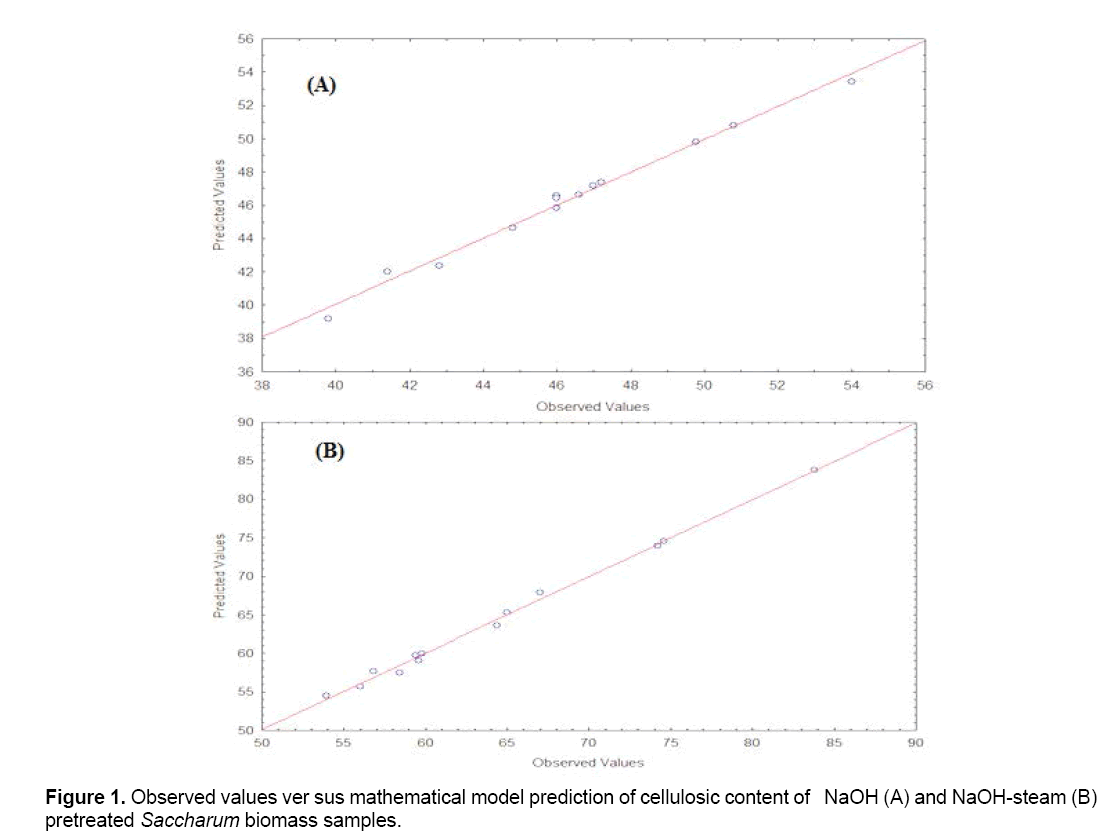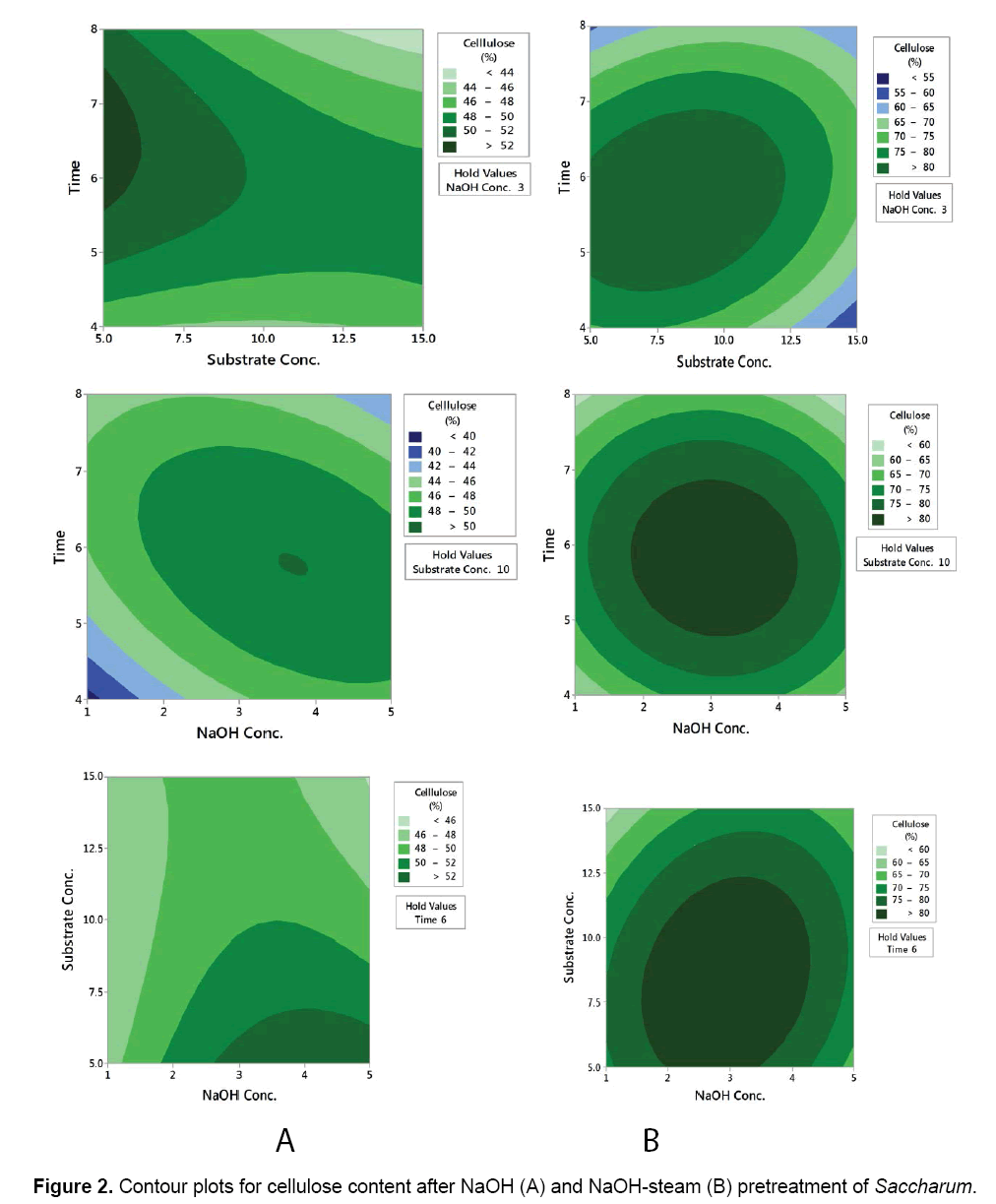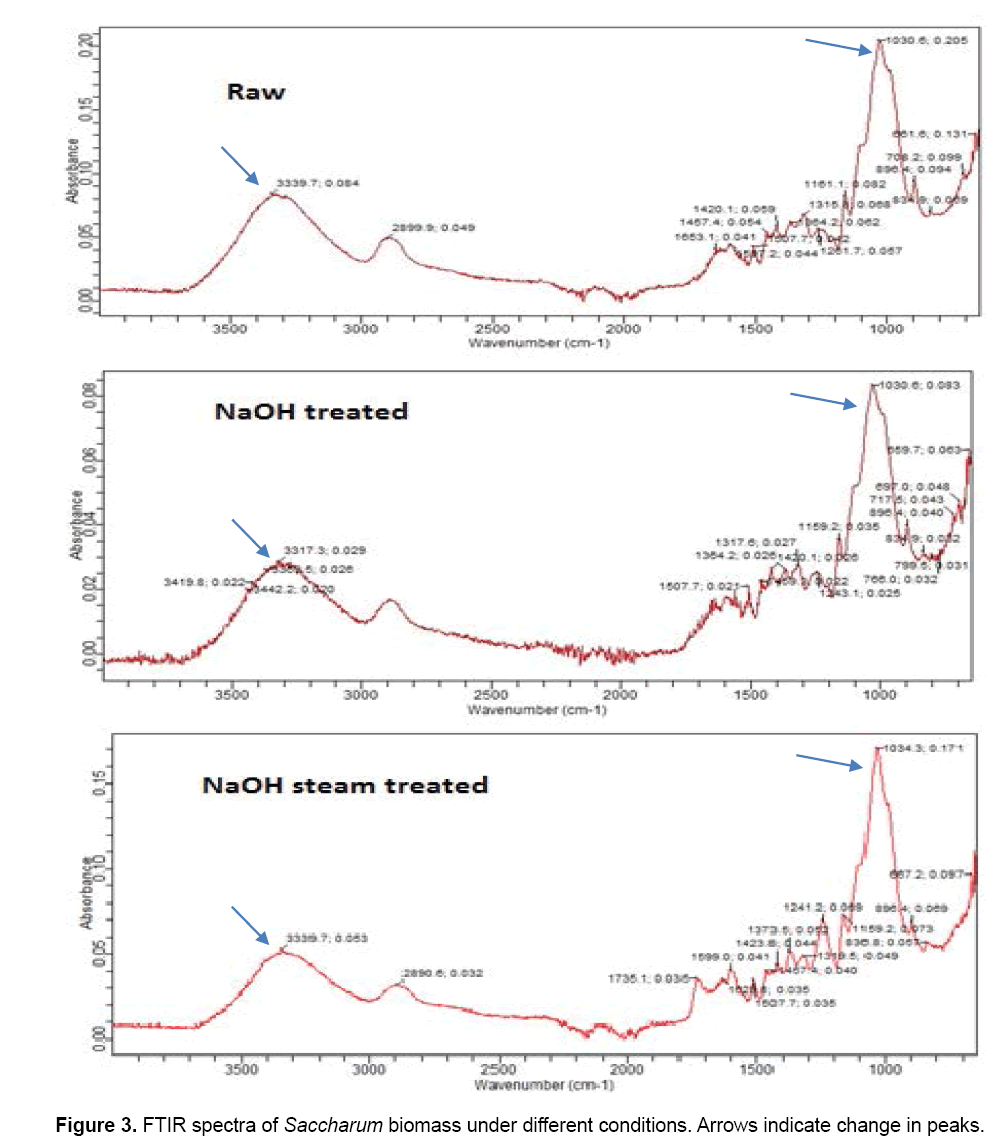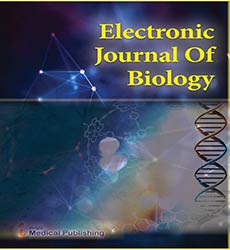Statistical Optimization of Alkali Pretreatment on Cellulose Content of Saccharum through Response Surface Methodology
Muhammad Irfan*, Fouzia Kanwal
Department of Biotechnology, University of Sargodha, Sargodha, Pakistan
- Corresponding Author:
- Muhammad Irfan
Department of Biotechnology, University of Sargodha, Sargodha, Pakistan
Tel: +923224099049
E-mail: irfan.biotechnologist@gmail.com
Received date: November 21, 2018; Accepted date: December 20, 2018; Published date: December 31, 2018
Citation: Irfan M, Fouzia K. Statistical optimization of alkali pretreatment on cellulose content of Saccharum through response surface methodology. Electronic J Biol, 14:4
Abstract
The aim of this study is to optimize pretreatment conditions for maximum cellulose content from Saccharum biomass. Three independent variables like NaOH concentration, substrate concentration and residence time with three levels were optimized using response surface methodology with and without steam condition. Results showed that cellulose content was enhanced from 40.2% of untreated Saccharum biomass to maximum 83.80% of NaOH-Steam pretreated Saccharum biomass. Optimized pretreatment conditions for maximum cellulose content achieved were 3% NaOH, 10% substrate and 6 h for NaOH-steam pre-treatment. FTIR (Fourier Transform Infra-red Spectroscopy) analysis revealed the effectiveness of pretreatment process. The proposed model was found statistically significant as revealed by corresponding F and p values.
Keywords
NaOH; pretreatment; cellulose; Saccharum; RSM.
Introduction
In the 21st century, energy demand is increasing day by day for transportation, heating and industrial use. Biomass fuel is a renewable source but still it is incomplete, natural biomass is a renewable energy source. Great efforts have been carried out to produce bio-fuels because it is believed that biofuels do not contribute to the greenhouse effect [1]. Because of less production of biofuels and increasing demand of energy needs another sources of energy that’s fulfill the energy demands, it is considered that lingocellulosic materials has been the important sources for fuels production [2,3]. A common biopolymer that is considered as the most significant resource for the production of biofuels is lingo-cellulosic biomass [4]. Biomass raw materials are commonly present in softwood, grasses, hardwoods, plants and agricultural residues. The composition of lignocellulosic material is hemi-cellulose (20%-35%), cellulose (35%-50%), and lignin (10%-25%), composition is different in all substrates and substrates processing [5].
Saccharum spontaneum biomass is considered as important biomass with affinity of ethanol production. It is crop of short rotational time with qualities of large scale production and needs less amount for starting all over the year. It is C4 plant having the quality to maintain photo-synthesis rate and good capacity for use of water in similar situation [6]. Cell wall of Saccharum composed of 68% carbohydrate which includes 43.78% cellulose and 24.22% hemicellulose for the production of bio-fuels [7]. It is widely present in zone of East, zone of central point and many countries causing discarding of fields [8,9].
Pretreatment is an important part in the conversions of bio-processes, because all its resulting products like sugar estimation (saccharification), ethanol production and other processes (downstream procedures) are the outcomes of pretreatment. The process of pre-treatment enhance the enzymatic hydrolysis, feedback, minimizes inhibitory compounds and include reasonable and efficient prices with less energy input and less amount of unwanted material [10,11].
The analysis (mathematical and statistical) of lingocellulosic material used for the modeling problems is Response Surface Methodology (RSM) that is affected by many variables of interest. Response surface methodology has been mostly used for evaluating various stages of biotechnological methods [12,13] and also used to analyze enzymatic hydrolysis. This study was designed to find optimum pretreatment conditions for Saccharum biomass through response surface methodology.
Materials and Methods
Biomass preparation
The Saccharum biomass was obtained from field of Shahkot, District Nankana Punjab, Pakistan. These Saccharum were cut down into small pieces, washed to remove redundant matters and oven-dried at 70°C until constant weight. Dried biomass was chopped and ground to fine powder with grinder and kept at room temperature in plastic bags.
Chemical pre-treatment
Sodium hydroxide solution with different concentrations (1%, 3% and 5% w/v) were mixed with different concentrations (5%, 10% and 15%) of biomass and placed at room temperature for different time periods (4, 6 and 8 h). After that the slurry was filtered and solid biomass was washed with distilled water until the pH become neutral. The solid residues were placed in an oven at 70oC till constant weight [14]. The fully dried material was packed in polythene bags and further used for cellulose analysis.
Thermo-chemical pre-treatment
Sodium hydroxide solution with different concentrations (1%, 3% and 5% w/v) were mixed with different concentrations (5%, 10% and 15%) of biomass and placed at room temperature for different time periods (4, 6 and 8h). After completing time, the samples were placed in an autoclave with conditions of 121oC for 15 min at 15 ibs pressure. After that the slurry was filtered and solid biomass was washed with distilled water until the pH become neutral. The solid residues were placed in an oven at 70oC till constant weight [14]. The fully dried material was packed in polythene bags and further used for cellulose analysis.
Cellulose estimation
Cellulose content was measured as described in Asghar et al. [15].
Fourier transform infrared spectroscopy (FTIR) Analysis
Agilent technologies Cary 630 FTIR was used to analyze the treated and untreated biomass and absorption spectrum was recorded in the range of 650-4000 cm-1 with resolution of 4.
Experimental design
Box-Bhenken design (BBD) of response surface methodology was used to conduct experiments. The variables used, their codes and levels are mentioned in Table 1.
| Independent Variable | Code | Code and actual factor level | ||
| -1 | 0 | +1 | ||
| NaOH concentration (%w/v) | a | 1 | 3 | 5 |
| Substrate concentration (g) | b | 5 | 10 | 15 |
| Reaction time (h) | c | 4 | 6 | 8 |
Table 1: Coded and actual level of the three independent variables for the pretreatment.
Statistical analysis
Minitab v. 17.0 Trial Version of Statistical software package was used to plot the response surfaces and regression analysis of experimental data. Statistical parameters were examined through Analysis of variance ANOVA. And values differences were showed in terms of probability p<0.05 values.
Results
Box-bhenken design of response surface methodology was used to analyze the effects and interaction of NaOH concentration, substrate concentration and reaction time over actual response of % cellulose content. The actual responses with their respective predicted responses for % cellulose of NaOH pretreated and NaOH-steam pretreated Saccharum samples are presented in Tables 2 and 3 respectively. The response obtained was calculated through second order polynomial regression equations as shown in equation 1 and equation 2 for NaOH and NaOH-steam pretreated substrate respectively. The cellulose content was increased from 40.2% to 83.8% in untreated and NaOH-steam treated Saccharum respectively. Among two types of pretreatments, NaOH with steam treatment was found very effective in achieving maximum cellulose content under conditions of 3% NaOH conc. and 10% substrate concentration with residence time of 6 h.
| Run # | a | b | c | Cellulose (%) | ||
|---|---|---|---|---|---|---|
| Observed | Predicted | Residue | ||||
| 1 | 3 | 10 | 6 | 49.7800 | 49.7800 | -0.00000 |
| 2 | 5 | 10 | 8 | 41.4000 | 42.0000 | -0.60000 |
| 3 | 5 | 15 | 6 | 46.0000 | 45.8250 | 0.175000 |
| 4 | 5 | 10 | 4 | 47.2000 | 47.3500 | -0.15000 |
| 5 | 5 | 5 | 6 | 54.0000 | 53.4250 | 0.575000 |
| 6 | 1 | 15 | 6 | 46.0000 | 46.5750 | -0.57500 |
| 7 | 3 | 5 | 4 | 46.0000 | 46.4250 | -0.42500 |
| 8 | 1 | 10 | 8 | 44.8000 | 44.6500 | 0.150000 |
| 9 | 3 | 15 | 8 | 42.8000 | 42.3750 | 0.425000 |
| 10 | 1 | 10 | 4 | 39.8000 | 39.2000 | 0.600000 |
| 11 | 1 | 5 | 6 | 47.0000 | 47.1750 | -0.17500 |
| 12 | 3 | 5 | 8 | 50.8000 | 50.7750 | 0.025000 |
| 13 | 3 | 15 | 4 | 46.6000 | 46.6250 | -0.02500 |
Table 2: BBD with the predicted and actual values of the experimental response for % cellulose of NaOH pretreatment of Saccharum biomass.
| Run # | a | b | c | Cellulose (%) | ||
|---|---|---|---|---|---|---|
| Observed | Predicted | Residue | ||||
| 1 | 3 | 10 | 6 | 83.80000 | 83.80000 | -0.00000 |
| 2 | 5 | 10 | 8 | 56.00000 | 55.63125 | 0.368750 |
| 3 | 5 | 15 | 6 | 65.00000 | 65.26875 | -0.26875 |
| 4 | 5 | 10 | 4 | 64.40000 | 63.56875 | 0.831250 |
| 5 | 5 | 5 | 6 | 67.00000 | 67.93125 | -0.93125 |
| 6 | 1 | 15 | 6 | 58.40000 | 57.46875 | 0.931250 |
| 7 | 3 | 5 | 4 | 74.60000 | 74.50000 | 0.100000 |
| 8 | 1 | 10 | 8 | 56.80000 | 57.63125 | -0.83125 |
| 9 | 3 | 15 | 8 | 59.80000 | 59.90000 | -0.10000 |
| 10 | 1 | 10 | 4 | 59.40000 | 59.76875 | -0.36875 |
| 11 | 1 | 5 | 6 | 74.20000 | 73.93125 | 0.268750 |
| 12 | 3 | 5 | 8 | 59.60000 | 59.03750 | 0.562500 |
| 13 | 3 | 15 | 4 | 53.95000 | 54.51250 | -0.56250 |
Table 3: BBD with the predicted and actual values of the experimental response for % cellulose of NaOH-steam pretreatment of Saccharum biomass.
Regression equation for % cellulose content of NaOH pretreated samples.
Celllulose (%) = -17.31 + 10.073a + 0.717b + 16.46c - 0.5975a2 + 0.0344b2 - 1.0225c2 - 0.1750ab - 0.6750ac- 0.2150bc (1)
Regression equation for % cellulose content of NaOH-steam pretreated samples.
Cellulose (%) = -46.99 + 14.32a + 0.806b + 37.83c - 2.561a2 - 0.2962b2 - 3.602c2 + 0.3450ab - 0.362ac + 0.5212bc
Significance of data was evaluated by analysis of variance and it was found that the model was very significant having F values of 166.93 and 218.47, and probability values of 0.000 and 0.000 for NaOH and NaOH-steam pretreated Saccharum biomass respectively (Tables 4 and 5). The model’s large F values and their corresponding p-values shows model’s accuracy (Figure 1). The coefficient of determination R2 values of 0.9905, 0.9974 and the adjusted R2 of 0.9734, 0.9927 indicates that actual results are in accordance with the values predicted by the model (Figure 1). The models can explain variations in responses up to 99.05% and 99.74%.
| Source | DF | Adj.MS | Adj.SS | F-Value | p-Value |
|---|---|---|---|---|---|
| Model | 9 | 192.947 | 21.4385 | 57.94 | 0.000 |
| Linear | 3 | 48.750 | 16.2500 | 43.92 | 0.001 |
| NaOH conc. (a) | 1 | 15.125 | 15.1250 | 40.88 | 0.001 |
| Substrate conc. (b) | 1 | 33.620 | 33.6200 | 90.86 | 0.000 |
| Time (c) | 1 | 0.005 | 0.0050 | 0.01 | 0.912 |
| Square | 3 | 84.297 | 28.0989 | 75.94 | 0.000 |
| a2 | 1 | 21.091 | 21.0908 | 57.00 | 0.001 |
| b2 | 1 | 2.731 | 2.7308 | 7.38 | 0.042 |
| c3 | 1 | 61.765 | 61.7653 | 166.93 | 0.000 |
| 2-way Interaction | 3 | 59.900 | 19.9667 | 53.96 | 0.000 |
| ab | 1 | 12.250 | 12.2500 | 33.11 | 0.002 |
| ac | 1 | 29.160 | 29.1600 | 78.81 | 0.000 |
| bc | 1 | 18.490 | 18.4900 | 49.97 | 0.001 |
| Error | 5 | 1.850 | 0.3700 | ||
| Lack-of-fit | 3 | 1.850 | 0.6167 | ||
| Pure Error | 2 | 0.000 | 0.0000 | ||
| Total | 14 | 194.797 |
Table 4: ANOVA for the regression equation of cellulosic content of NaOH pretreated Saccharum biomass.
| Source | DF | Adj SS | Adj MS | F-Value | p-Value |
|---|---|---|---|---|---|
| Model | 9 | 1595.24 | 177.249 | 211.73 | 0.000 |
| Linear | 3 | 235.26 | 78.419 | 93.68 | 0.000 |
| NaOH conc. (a) | 1 | 1.65 | 1.620 | 1.94 | 0.223 |
| Substrate conc. (b) | 1 | 182.88 | 182.883 | 218.47 | 0.000 |
| Time (c) | 1 | 50.75 | 50.753 | 60.63 | 0.001 |
| Square | 3 | 1195.28 | 398.427 | 475.95 | 0.000 |
| a2 | 1 | 387.45 | 387.450 | 462.83 | 0.000 |
| b2 | 1 | 202.53 | 202.532 | 241.94 | 0.000 |
| c3 | 1 | 766.30 | 766.302 | 915.40 | 0.000 |
| 2-way Interaction | 3 | 164.70 | 54.900 | 65.58 | 0.000 |
| ab | 1 | 47.61 | 47.610 | 56.87 | 0.001 |
| ac | 1 | 8.41 | 8.410 | 10.05 | 0.025 |
| bc | 1 | 108.68 | 108.681 | 129.83 | 0.000 |
| Error | 5 | 4.19 | 0.837 | ||
| Lack-of-fit | 3 | 4.19 | 1.395 | ||
| Pure Error | 2 | 0.00 | 0.000 | ||
| Total | 14 | 1599.42 |
Table 5: ANOVA for the regression equation of cellulosic content for NaOH-steam pretreated Saccharum biomass.
Figure 2 shows 2-D contour plots for NaOH (A) and NaOH-steam (B) pretreatment. These graphs were plotted between three variables keeping one variable constant. These plots indicated that each variable had significant effect on cellulose content. Different color bands in these plots indicated different range of cellulose content at different conditions.
FTIR spectroscopy was used to examine pretreatment effect on functional group of Saccharum biomass through chemical modifications. FTIR spectra for untreated, NaOH pretreated, and NaOH-Steam pretreated Saccharum are shown in Figure 3. Results indicated that some peaks decreased their intensity in pretreated samples as compared to untreated which showed degradation of hemicellulose or lignin as a result of pretreatment. Peak at 1599.1cm-1 in raw, indicating aromatic vibrations C=O stretch for lignin in raw which was changed to 1507.7 cm-1 in NaOH and 1537.2 cm-1 in NaOH steam treatment. Strong peak for cellulose and hemi-cellulose was found at wavenumber 1034.3 cm-1 in untreated Saccharum material. Decrease in intensity of peak from 1034.3 cm-1 to 1030.6 cm-1 and 1030.6 cm-1 in pre-treated samples shows stretching of C-O, C=C, and C-C-O. At 667.2 cm-1 in raw the peak became sharper in base pre-treated at 670.9 cm-1 showing glycosidic linkage for hemicelluloses. While for base steam the peak was at 661.6 cm-1.
Discussion
Saccharum spontaneum (Kans grass) is considered as good source for the production of biofuels [6]. Kans grass cell wall consists of 68% carbohydrate on dry mass, contains 43.78% cellulose and 24.22% hemicelluloses [7]. Lignocellulosic biomass pretreatment causes lignin degradation and disrupt cellulose crystalline structure and makes it susceptible to enzymes and acid attack for hydrolysis [16]. Alkaline pretreatment removes lignin while other components integrity is maintained, and uses lower temperature and pressure then other pretreatment techniques [17]. NaOH is considered as an efficient chemical reagent for ligno-cellulosic biomass delignification [1]. In this study, sodium hydroxide (NaOH) was used for Saccharum biomass pretreatment. Alkaline pretreatment is observed as an effective pretreatment technique for delignification of lignocellulosic material. Saccharum biomass was pretreated with 1%, 3% and 5 % concentrations of NaOH with 5%, 10% and 15% biomass concentration for 4, 6 and 8 h of residence time. The sodium hydroxide effectively degraded the biomass resulting increased cellulose content up to 83.80% after pretreatment. Sodium hydroxide is best for the pretreatment process for various substrates like grass and straws [15]. It was previously reported that when soaking time was 24 h, maximum cellulose (47%) was noted in kallar grass (Leptochloa fusca), although a decline was observed when soaking time was increased to 48 h [18]. At 1210C for 90 min, substrate Saccharum was used at 2% NaOH and 65% delignification was noticed [19].
Sun and Cheng [20] stated that many changes occur when lingo-cellulosic material was treated with dilute NaOH. Ligno-cellulosic material swells, which enhancing the surface area, decreases the amount of polymerization, crystallinity reduction and structural association break up between carbohydrates and lignin. Ruangmee and Sangwichien [21] also reported similar findings with increased cellulose content at optimized pretreatment conditions of 5% NaOH concentration and 120 min reaction time at 100oC of narrow-leaf cattail. Increased concentrations of NaOH and time could increase the cellulose content of oil palm fronds biomass [22].
In this study BBD of response surface methodology was applied to optimize pretreatment conditions for Saccharum biomass. Most of the research work on pretreatment conditions optimization was done through response surface methodology and most of their results are widely accepted as reported previously [21,23]. The proposed model in this study was found significant as revealed by their probability values.
FTIR was used to study the physiochemical and conformational properties of pretreated Saccharum biomass samples. Previous studies indicated that FTIR spectrum is very helpful in studying the effects of different pretreatment on biomasses showing degradation of lignin, hemicellulose and cellulose in terms of bond vibrations between different functional groups [24-25].
Conclusion
RSM was used for evaluation of independent variables and their response. Pretreated Saccharum biomass showed enhanced cellulose content from 40.2% of untreated Saccharum biomass to maximum 83.80% of NaOH-Steam pretreated Saccharum biomass. Optimized pretreatment conditions for maximum cellulose content achieved were 3% NaOH, 10% substrate and 6 h for NaOH-steam pre-treatment.
References
- Wang M, Zhou D, Wang Y, et al. (2009). Bioethanol production from cotton stalk. A comparative study of various pretreatments. Fuel. 184: 527-532.
- Oliva JM, Manzanares P, Ballesteros I, et al. (2005). Application of Fenton’s reaction to steam explosion prehydrolysates from poplar biomass. In Twenty-Sixth Symposium on Biotechnology for Fuels and Chemicals pp. 887-899.
- Sassner P, Mårtensson CG, Galbe M, et al. (2008). Steam pretreatment of H2SO4-impregnated Salix for the production of bioethanol. Bioresource Technol. 99: 137-145.
- Zhang QZ, Cai W. (2008). Enzymatic hydrolysis of alkali pretreated rice straw by Trichoderma reesei ZM4-F3. Biomass Bioenergy. 32: 1130–1135.
- Sánchez C. (2009). Lignocellulosic residues: biodegradation and bioconversion by fungi. Biotechnol. Adv. 27: 185-194.
- Osborne CP, Freckleton RP. (2008). Ecological selection pressures for C4 photosynthesis in the grasses. Proceedings of the Royal Society of London B: Biological Sciences, rspb-2008.
- Singh LK, Chaudhary G, Majumder CB, et al. (2011). Explore the perennial Kans grass (Saccharum spontaneum) biomass for releasing reducing sugars and its optimization. Der Chemica Sinica, 2: 154-163.
- Naidu KM, Sreenivasan TV. (1987). Conservation of sugarcane germplasm. In Proceedings of the Copersucar International Sugarcane Breeding Workshop. Copersucar Technology Centre, Piracicaba-SP, Brazil pp. 33-53.
- Saritha M, Arora A, Lata. (2012). Biological pretreatment of lignocellulosic substrates for enhanced delignification and enzyme digestibility. Indian J Microbiol. 52: 122-130.
- Drapcho CM, Nhuan NP, Walker TH. (2008). Biofuels engineering process technology. New York, NY, USA: McGraw-Hill. 334-335.
- Kim S, Holtzapple MT. (2005). Lime pretreatment and enzymatic hydrolysis of corn stover. Bioresource Technol. 96: 1994-2006.
- Alvira P, Tomás-Pejó E, Ballesteros M, et al. (2010). Pretreatment technologies for an efficient bioethanol production process based on enzymatic hydrolysis. Bioresource Technol. 101: 4851–4861.
- Li C, Knierim B, Manisseri C, et al. (2007). Comparison of dilute acid and ionic liquid pretreatment of switchgrass: biomass recalcitrance, delignification and enzymatic saccharification. Bioresource Technol. 101: 4900-4906.
- Iqbal S, Irfan M, Shakir HA, et al. (2017) Effect of alkali treatment (NaOH) of eucalyptus leaves for hypercellulase production Bacillus subtilis through submerge fermentation. Punjab Univ J Zool. 32: 25-34.
- Asghar U, Irfan M, Iram M, et al. (2015). Effect of alkaline pretreatment on delignification of wheat straw. Nat. Prod. Res. 29: 125-131.
- Kumar R, Wyman CE. (2009). Effects of Cellulase and Xylanase Enzymes on the deconstruction of Solids from Pretreatment of Poplar by Leading Technologies. Biotechnol. Prog. 25: 302–314.
- McMillan JD. (1994). Pre-treatment of lignocellulosic biomass, in Enzymatic Conversion of Biomass for Fuels Production, ed by Himmel ME, Baker JO and Overend RP. American Chem. Soci, Washington pp. 292–324.
- Nadeem M, Ashgar U, Abbas S, et al. (2013). Alkaline pretreatment: A potential tool to explore kallar grass (Leptochloa fusca) as a substrate for bio-fuel production. Middle-East J. Sci. Res. 18: 1133-1139.
- Silverstein RA, Chen Y, Sharma-Shivappa RR, et al. (2007). A comparison of chemical pretreatment methods for improving saccharification of cotton stalks. Bioresource Technol. 98: 3000-3011.
- Sun Y, Cheng J. (2002). Hydrolysis of lignocellulosic materials for ethanol production: A review. Bioresource Technol. 83: 1-11.
- Ruangmee A, Sangwichien C. (2013). Statistical optimization of alkali pretreatment conditions of narrow-leaf cattail by response surface methodology. Songklanarin J. Sci. Technol. 35: 443-450.
- Sukri SS, Roshanda A, Rahman, et al. (2014). Optimization of alkaline pretreatment conditions of oil palm fronds in improving the lignocelluloses contents for reducing sugar production. Romanian Biotechnol Lett. 19: 9006-9018.
- Ghazanfar M, Irfan M, Nadeem M. (2018) Statistical modeling and optimization of pretreatment of Bombax ceiba with KOH through Box-Bhenken design of response surface methodology. Energy Sources Part A. 40:1114-1124.
- Irfan M, Asghar U, Nadeem M, et al. (2016) Statistical optimization of saccharification of alkali pretreated wheat straw for bioethanol production. Waste Biomass Valor. 7: 1389-1396.
- Zhang A, Liu C, Sun R, et al. (2013). Extraction, purification, and characterization of lignin fraction from sugarcane bagasse. Bioresources. 8: 1604–1614.

Open Access Journals
- Aquaculture & Veterinary Science
- Chemistry & Chemical Sciences
- Clinical Sciences
- Engineering
- General Science
- Genetics & Molecular Biology
- Health Care & Nursing
- Immunology & Microbiology
- Materials Science
- Mathematics & Physics
- Medical Sciences
- Neurology & Psychiatry
- Oncology & Cancer Science
- Pharmaceutical Sciences



